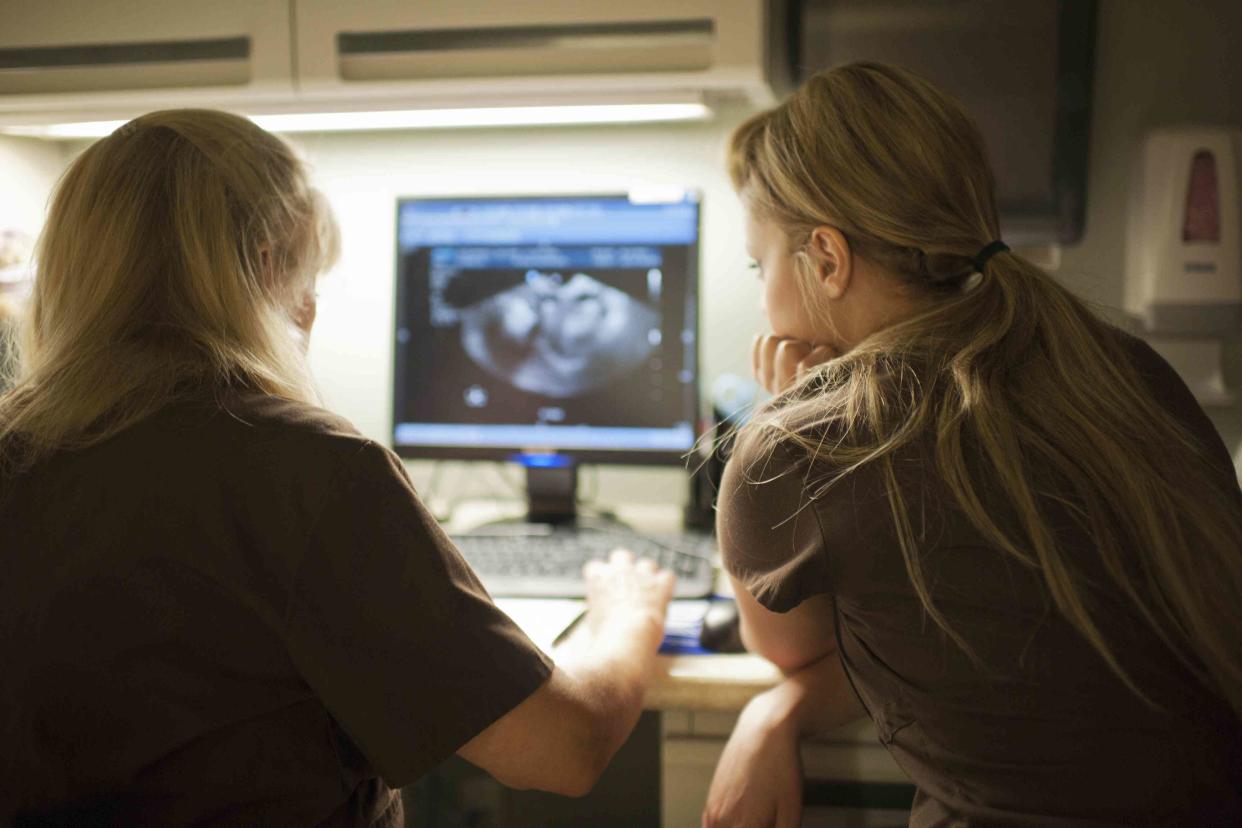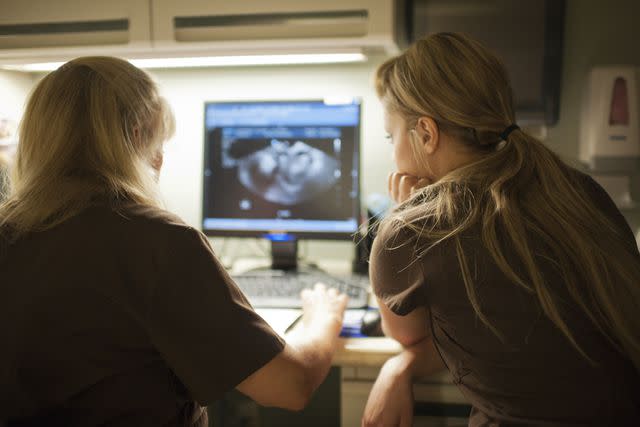Everything You Need to Know About Hydrops Fetalis

Reza Estakhrian / Getty Images
Medically reviewed by Lyndsey Garbi, MD
Hydrops fetalis, also known as fetal hydrops, is a severe problem in unborn and newborn babies. It is the collection of fluid in two or more chambers of the baby's body. Without treatment, the excess fluid can threaten the baby's life. The fluid can harm the baby's heart and other vital organs.
Hydrops fetalis is not a disease on its own. It is a symptom of many diverse health problems affecting the fetus or newborn. These issues can impact the baby's heart, lungs, genes, and immune system.
Diagnosis of this problem usually takes place while the baby is a fetus. The treatment and prognosis of a baby with this condition can vary significantly based on the health issue causing the problem.
This article describes hydrops fetalis symptoms, causes, diagnosis, treatment, and outlook.

Reza Estakhrian / Getty Images
Types of Hydrops Fetalis
There are two types of hydrops fetalis:
Nonimmune hydrops fetalis: Nonimmune hydrops fetalis is the most common type, affecting up to 90% of all babies with this disorder. It is linked to an underlying disease or other problem that interferes with a baby's ability to manage fluid.
Immune hydrops fetalis: Immune hydrops fetalis occurs when the mother's immune system attacks the unborn baby's red blood cells due to an incompatibility between the mother and the baby's red blood cells. This results in the breakdown of the baby's red blood cells.
Hydrops Fetalis Symptoms
Symptoms of hydrops fetalis may occur differently in every baby.
The following symptoms of hydrops fetalis can occur during pregnancy:
Large amounts of amniotic fluid
Abnormal accumulation of fluid in two or more fetal body cavities
Thickened placenta (a temporary organ that provides nutrients to the baby during pregnancy)
Skin thickening of at least 5 millimeters
Cystic hygroma (a large fluid-filled cyst that forms on the baby's neck)
Pleural effusion (an accumulation of fluid in the area between the layers of tissue that line the chest cavity and lungs)
An enlarged liver, spleen, or heart
Evidence of fluid buildup around the baby's abdominal organs, heart, or lungs on ultrasound images
Massive anasarca (swelling of the entire body) in the mother
Preeclampsia (hypertension, or high blood pressure, in the mother)
Proteinuria (high levels of protein in the urine) in the mother
The following hydrops fetalis symptoms can occur immediately at birth:
Pale coloring
Jaundice (yellowing of the skin, tongue, and/or eyes)
Trouble breathing
Severe widespread swelling, especially in the baby's belly (abdomen)
Enlarged liver and spleen
Cardiac dysfunction
Causes
Causes of hydrops fetalis vary greatly. The type of hydrops fetalis that a baby has is based on its causes.
Nonimmune Hydrops Fetalis
There are many possible causes of nonimmune hydrops, including the following:
Birth defects that affect how the baby's heart functions
Birth defects that involve a tumor that compresses the heart or blood flow to the baby's heart
A hemoglobin abnormality or other genetic disease that destroys the baby's blood cells
Down syndrome (a genetic condition in which the baby has an extra copy of chromosome 21), Turner syndrome, or other chromosomal disorders
Tumors with a large amount of blood flow
Infections present before birth
Severe anemia (low red blood cell count)
A monochorionic pregnancy (a pregnancy involving identical twins who share one placenta)
Immune Hydrops Fetalis
Immune hydrops fetalis is triggered when the mother's immune system attacks the unborn baby's red blood cells. This often occurs because of the Rhesus (Rh) factor protein. If the mother is Rh negative and the baby is Rh positive, the mother's immune system identifies the unborn baby's red blood cells as "foreign invaders." It fights them with antibodies, destroying the baby's red blood cells. Anemia can occur.
In most red blood cell incompatibility cases, the baby experiences only mild to moderate health problems. However, in about 25% of these cases, the baby's organs can't overcome anemia, and the heart can start to fail. This causes large amounts of fluid to collect in the baby's tissue and organs.
Diagnosis
A diagnosis of hydrops fetalis usually takes place before the baby is born. It may involve the following studies:
Ultrasound: A routine ultrasound during the second or third trimester of pregnancy usually makes a diagnosis of hydros fetalis. However, the 12-week ultrasound may detect it during early pregnancy if it occurs due to chromosomal abnormalities. A diagnostic ultrasound may also take place if there is cause for concern. This may include a baby who is larger than is healthy at its gestational age, a significant decrease in the baby's movements, or early onset preeclampsia. An ultrasound applies sound waves to produce images of the baby's organs, blood vessels, and tissues and how blood flows through different vessels. It can also show evidence of swelling and fluid buildup around the baby's heart, lungs, liver, and other organs.
Fetal blood sampling: This involves placing a needle through the mother's uterus and into the umbilical cord or one of the baby's blood vessels to analyze the baby's blood.
Maternal blood typing: The mother's blood may be tested for antibodies linked with the red blood cell incompatibility of the Rh factor.
Amniocentesis: A small needle enters the amniotic sac through the mother's abdomen to remove some of the amniotic fluid that surrounds the fetus. This fluid contains some of the baby's chromosomes. It is assessed for genetic or chromosomal abnormalities, infection, or liver and metabolic diseases.
Treatment
Treatment for hydrops fetalis varies based on the cause of the condition, the extent, and the severity of the condition as well as the baby's gestational age. In many cases, treatment during pregnancy isn't possible.
When possible, treatments can include the following types of interventions:
Administration of RhoGAM (Rho (D) immunoglobulin) to women with Rh-negative blood
Fetal blood transfusion (the injection of red blood cells from a compatible donor into the baby's umbilical cord to treat anemia)
Prenatal surgery to remove a tumor or treat problems caused by monochorionic twin pregnancies
Administration of oral medication for cardiac arrhythmia (irregular heartbeat) given to the mother so the drug passes through the placenta to the baby
Removal of excess fluid with a needle or administration of a shunt to continuously drain fluid
Use of extra oxygen or a ventilator (breathing machine) for babies with breathing problems at birth
Removal of excess fluid around the lungs and abdomen as necessary at birth
Delivery of the baby via cesarean section, with postnatal treatment in a neonatal intensive care unit (NICU) for specialized medical care immediately after birth
Whether treatment is possible or not, the goal is to help the baby avoid an early delivery, which could threaten the baby's life. However, in some cases, the mother can develop "mirror syndrome," in which the mother's symptoms "mirror" the fluid buildup in the baby. This condition requires the immediate delivery of the baby.
Rarity of Immune Hydrops Fetalis
The incidence of immune hydrops fetalis has significantly dropped since the 1960s when a medicine called RhoGAM was introduced. Women who have a pregnancy at risk of Rh incompatibility are routinely given this drug. RhoGAM prevents the mother's immune system from making antibodies that destroy her baby's red blood cells.
Prognosis
The prognosis for hydrops fetalis is affected by Multiple factors including underlying causes and the success of treatment affect the prognosis of hydros fetalis. Generally, the prognosis for babies with this condition is poor, with about a 50% survival rate.
Coping
A diagnosis of hydrops fetalis during pregnancy usually requires close monitoring of the pregnancy whether treatment is performed or not. You can expect close monitoring and testing to evaluate the baby's health from the diagnosis.
Management of a pregnancy involving a baby with hydrops fetalis is usually handled by a multidisciplinary care team that can include a maternal-fetal specialist, pediatric cardiologist, neonatologist, geneticist, nurse specialist care coordinator, and other specialists who can cater to the physical and emotional challenges of having a baby with this condition.
Summary
Hydrops fetalis involves the collection of fluid in an unborn or newborn baby. With this problem, the fluid exists in at least two chambers of the baby's body. The problem can cause excess fluid around the baby's heart and other organs. This, in turn, can cause a severe issue that can threaten a baby's life.
Hydrops fetalis can occur as a symptom of many types of birth defects. It can also evolve due to a blood incompatibility between the mother and the baby owing to differences in their blood's Rh factors.
Though routine ultrasound finds most cases, symptoms such as decreased fetal movement may trigger the need for further tests to assess the baby's health. In some cases, the mother may also have health problems resulting from the condition, causing the need for an early delivery.
Women whose babies have this problem should expect close monitoring and testing until the baby is born. The goal is to optimize delivery timing based on symptoms in utero. The advised treatment and outcomes can vary based on the health problem causing the issue.

